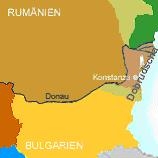
The Germans from the DobrudjaDefinitionThe Dobrudja was a geographical region between the lower Danube and the Black Sea. It had been under Turkish rule until 1878 when its northern part was given to Rumania; in 1913 the southern part held by Bulgaria since 1878 also became part of Rumania. Today, its northern part belongs to Rumania, the southern part to Bulgaria. 
Source: http://www.osteuropa-infoseite.de/dobrudscha.htm SettlementGerman colonists—mostly from Bessarabia and Ukraine—began to settle in the area as early as the 1840s while it was still part of the Ottoman Empire. Between 1873 and 1878 several more migrations took place. Some of the Germans who had emigrated to Bessarabia continued their march southward. In 1842, some 6,000 immigrated into Romania and founded Jakobstal near Braila. Some of them felt dissatisfied and went to the Dobrogea, establishing themselves at Tulcea and Babadag and in the district of Constanta. In 1878, together with the whole district, their colonies went to Romania. [1] When the Dobrudja came to Romania in 1878, the Germans who had been left pretty much alone by the previous Turkish authorities (except for the collection of taxes, of course), now faced discrimination and bureaucratic difficulties. New immigrants from Russia after 1890 were no longer able to acquire any land. By the mid-1880s, hundreds of families emigrated to the Dakotas, and from there a sizeable number continued their migration to western Canada. [2] By 1913, thirty German colonies were founded, and as late as the 1920s daughter colonies were still being founded. The population was predominantly rural, but there were also some Germans in Constanta on the Black Sea. Next to the Rumanians (40% of the population in 1930) and the Bulgarians (25%), the Germans (1.5%) were one of many other smaller ethnic groups. [3] Following agreements between the Reich and Rumania and Bulgaria in 1940/41, the approximately 16,000 Germans were resettled. About 6,000 colonists each were moved to the Reich Protectorate Bohemia and Moravia and the Warthe-Gau. Like other recent arrivals, they fled or were expelled in 1945. [4] Settlement in Western CanadaAs early as 1885, a surprisingly large emigration to western Canada took place from the German villages in the Romanian Dobrudja. They were Baptists from the village of Tulcea, who founded the colony of Neu-Tulcea in Saskatchewan which later became Edenwold. Others came from Ciucurova, Cataloi and Caramurat and many smaller villages. In Saskatchewan, Germans from the Dobrudja also settled in Balgonie, Josephstal, Kronau, Davin and near St. Boswells, Kelstern, Morse, Blumenfeld and Bergfeld. Many of them had to move again because of poor agricultural conditions in the dry areas of the province. [5] Notes[1] "German genealogy: Dobrudscha," http://www.genealogienetz.de/reg/ESE/dobruja.html. Accessed on April 18, 2004. [2] Lehmann, Heinz, The German Canadians: 1750-1937. Immigration, settlement and culture. Translated, edited and introduced by Gerhard P. Bassler (St. John's, NF: Jesperson Presss, 1986), pp. 125-126. [3]"Die Dobrudscha- und Bulgariendeutschen," http://www.z-g-v.de/aktuelles/?id=56#dobrudscha. Accessed on April 18, 2004. [4] Ibid. [5] Lehmann, p. 127. |
